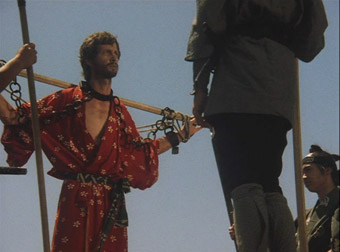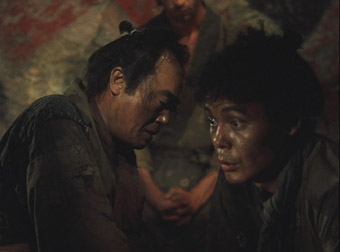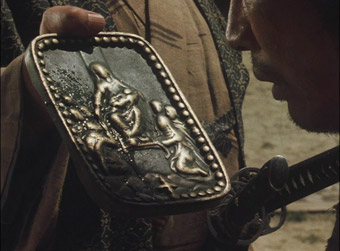| "In
this world neither God nor Buddha exists. There's nothing
at all any more." |
Monica, the wife of a martyred Christian samurai,
imprisoned for her choice of religion |
It's difficult to detach yourself from your own beliefs
and prejudices when reviewing a film whose subject matter
lights a touchpaper under them. Such is the case with
Shinoda Masahiro's 1971 Silence [Chinmoku],
a compellingly made and grimly effective story of religious
persecution in which I, somewhat perversely, occasionally found myself
siding with the views of the persecutors rather than their
victims. But I'll come to that.
The
setting is 16th century Japan, a time in which Christianity
has been banned and the worshipping of the Christian God
an offence punishable by torture and death. The religion
itself first took root as an import from Portugal some years
earlier, when missionaries and their work were tolerated as harmless.
But when the converted Christians put obedience to their
God above that to their Shogun, this collective insubordination
was seen as a threat, hence the 1587 and 1597 banning orders
issued by Toyotomi Hideyoshi, who executed 26 Franciscan
missionaries as a warning to others who might follow in
their footsteps. Followers of the Christian religion were
driven underground, and by 1638 Christianity was all but
extinct in Japan.

Silence
opens during this period of religious oppression, as two
Portuguese Christian missionaries – Fathers Rodriguez (David
Lampson) and Garrpe (Don Kenny) – arrive somewhere on the
shore of what is probably Kyushu (it's never clearly identified)
under the cover of darkness. They are met by a small group
of Japanese Christians, who welcome their patronage and dedicate
themselves to keeping the presence of the pair on Japanese
soil a secret. As the persecution of the Christian locals
continues and the hunt for the missionaries intensifies,
Garrpe and Rodriguez become separated, and the latter reluctantly
falls in with scruffy Kichijiro, the only one of the village
Christians to submit to pressure from the authorities and
denigrate the fumi-e, a plaque bearing sacred Christian
imagery designed specifically to expose the religion's followers
by requiring them to step or spit on it. His subsequent
collaboration leads to the arrest of Rodriguez, and while
the Padre debates his fate and beliefs with his captors,
Kichijiro struggles with his guilt and a desire for redemption.
That the story is told largely from a Christian viewpoint
is unusual for Japanese cinema, but not so strange given
that the screenplay was co-written by renowned Japanese
scholar and devout Catholic Shusaku Endo, based on his own
widely respected novel. Its parable structure casts the
bearded and bedraggled Father Rodriguez as Jesus, complete
with loyal followers, a wilderness wandering, an oppressive
ruling government, a walk through hostile crowds with his
arms tied to crossbeam, and a Judas figure in the shape
of Kichijiro, who trades Rodriguez in for 300 pieces of
silver, an inflationary build on the 30 of his infamous
forebear. Functioning primarily as a story of the testing
of Christian faith and the reaction of the Japanese authorities
of the time to the perceived threat it represented, the
film also questions whether Christianity could ever really
take hold in Japan, though the suggestion is that without
such rigid repression it may have achieved a more widespread
acceptance.
The concept of a foreign religion as an alien and potentially
disruptive force is not sidestepped here and becomes the
subject of arresting debate between Rodriguez and his captor
Inoue. Both men are shown to be intransigent in their views,
but Rodriguez's increasingly self-righteous indignation
makes it disarmingly easy to sympathise with his unruffled
and smiling host. It is in these exchanges that the film
touches on the key question of the validity of one version
of spiritual truth over another, with the missionaries functioning
as disruptive invaders whose word of God is not necessarily
any more correct than the one they are seeking to usurp.

They are also hopeless unprepared for the consequences
that their actions and even their mere presence could have for others. "You
selfishly force your own dreams on us," Inoue says
to Rodriguez, as those the Padre has come to assist are
systematically drowned to prompt him and Garepe to recant
their faith. "You never think of the bloodshed you
are causing." It's
a valid comment that strikes at the very heart of the missionaries'
calling, and marks an effective dividing line between the
devout and those for whom religion itself represents a self-imposed
method of intellectual oppression. For many of the more
committed Christians, teaching the gospel and the conversion
of unbelievers is central to their calling, and they do not
see national or cultural differences as barriers to this.
But for those not sympathetic to the Christian teachings,
such actions are equitable to those of an enterprising heroin
dealer, using deception to create a market for a product
the user has no real need for, but on which they will ultimately
become dependent. Just how sympathetic you are to Rodriguez's
fate will depend to a large part on which side of this line
you stand. Certainly, it's hard not to feel for anyone victimised
and humiliated by a force that is both powerful and morally
repressive, but even as I watched and sympathised with unrepentant
Christians as they are beaten and crucified in water until drowned by
the tide, I was reminded of tortures that easily eclipsed
those being administered here, dished out to the falsely
accused by the Inquisition in the name of their Christian
God.
This
inevitably raises the familiar issue of how we judge the
actions and beliefs of cultures other than our own, and
one of the very real strengths of Silence
is that the criticism comes not from a superior minded outsider
but from within, a moral questioning by a Japanese writer
and Japanese filmmakers of a troubling aspect their own
history. Shinoda never sentimentalises the conflict or Rodriguez's
role in it, taking almost an observer's view of events that
is repeatedly punctuated by arresting wide shots and telling
close-ups, captured in partially desaturated colour by master
cinematographer Kazuo Miyagawa.
The soundtrack is also noteworthy, the use of ambient sound and a sometimes hauntingly avant-garde score by Kwaidan
and Woman in the Dunes composer Toru Takemitsu
having an almost expressionistic quality, an externalisation
of the isolation and inner turmoil suffered by Rodriguez
as his quest crumbles and the worshippers he came to help
are killed.

If
what makes a story work lies at least in part in the manner
of its telling, then it is here that Silence
transcends any barriers that its subject matter may throw
up. Strip the film of its religious clothing and it becomes
a story of the repression of freedom of speech and thought,
of ideas considered contrary or even dangerous to those
of the state and the power that can be exercised to suppress
them. This reading is particularly evident in the powerful
final scenes, which do not play to expectations and are
open to multiple interpretations, none of which make for
particularly comfortable viewing, whatever your beliefs may
be.
The
religiously sympathetic have expressed admiration for the
film's gripping and insightful exploration of faith and
sacrifice, and I have no quarrel with this. For the power
of its filmmaking and its refusal to demonise the opposing
point of view, Silence is an important
and arresting film. Nonetheless, the cultural and religious
elements remain central to its story and message and will
inevitably effect how you read it. My first viewing of the
film was in the company of an older generation Japanese
friend of the Shinto religion, and she remained largely unsympathetic
to Rodriguez and his fate. At one point, the Padre's cheerful
escort describes Christianity as "an unwelcome gift
forced on the receiver," adding, "We have our
own religion. We don't need yours." My friend's reaction
was instantaneous – she pointed at the screen in annoyance
and snapped "Exactly!"
Framed
in its original 1.37:1 ratio, the early signs are not that
promising, with picture detail and contrast lost in the
dark of caves and day-for-night shooting, and the black
levels are sometimes not quite there. Outside it's a different
matter, with the detail crisp and the contrast well balanced. The partial colour desaturation and
brown tint are both deliberate, described nicely in the
accompanying booklet as "a style reminiscent of early
woodblock prints." Grain is visible throughout, but
the print is clean of dirt and scratches. As with several
recent MoC releases, this is an NTSC disc, avoiding standards
conversion issues.
The
Dolby 2.0 mono soundtrack Is clear with only a slight treble
bias, but does well enough by the sound effects and music.
The
optional English subtitles are clear – what does catch you
by surprise is that the English spoken dialogue is subtitled
in Japanese. These are burned-in and clearly part of the
print this transfer was sourced from – my co-viewer was
particularly happy to see them.
Historical
Texts
A DVD-ROM feature that contains reproductions of two historical
texts in PDF format: A History of the Missions in Japan
and Paraguay by Cecilia Mary Caddell (314 pages, 1856)
and Japan's Martyr Church by Sister Mary Bernard
(130 pages, 1926). Of genuine historical interest, they
will nonetheless prove impossibly heavy going and even annoying
to the non-religious.
Booklet
The Expected Masters of Cinema booklet is thinner than some
and contains only one essay, Masahiro Shinoda's Silence
by Doug Cummings, but it's a damned good one, providing
detailed background on the religious politics of the time
and place and a fascinating analysis of key aspects of the
film.
Silence
is a rarity in Japanese cinema in taking a critical view
of its own past from a Christian perspective, yet it stands
apart from most western tales of religious persecution through
its coolly observation approach and the considered arguments
it allows the opposition. Belief is in no way essential
to understanding and appreciation, but to get the very most
out of the what the film has to offer, it probably helps.
The transfer is generally up to the usual Masters of Cinema
standard, with only the darkest scenes falling a little
short.
A
final note – an American remake of the film is apparently
in pre-production as I write, to be directed by none other
than Martin Scorsese. [Since this review was posted, the film has been completed and released to some acclaim.]
|